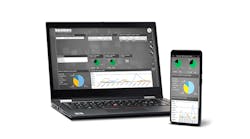Not just anybody can perform effective pressure calibrations. And especially with today’s highly stable, precise instrumentation, any drift in the applied calibration pressure due to small leaks or pump idiosyncrasies can result in doing more harm than good.
With enough time, an experienced technician can perform excellent calibrations with a hand pump, but newer technicians and old hands in a hurry will appreciate the main feature of the new Fluke 729 Automatic Pressure Calibrator: an internal electric pump that provides automatic pressure generation and regulation.
“The 729 makes pressure calibration easier, with less tribal knowledge,” says Jim Shields, product manager, process calibration tools, at Fluke Corp. “You just enter the pressure, press a button, and it goes there and holds it. There’s no need to squeeze or push a pump, or turn a knob to regulate pressure.”
[sidebar id =1]
The instrument can automatically test multiple pressures and document the results. “Calibration is as easy as typing in the starting and ending pressure, the number of test points and tolerance level,” Shields adds. “The 729 automatically regulates pressure and compensates small leaks using stored compressed air and miniature proportional air valves. These same valves control pressure for descending step tests by releasing air from the test port.”
Air pressure is generated and controlled as high as 300 psi (20 bar, 2 MPa). “Its 14-V lithium battery stores enough capacity to pump up to 300 psi something like 50 times,” Shields says. “It’s good for a typical week’s worth of testing.”
Calibrations can be documented using defined templates for transmitters and switches. The 729 documents the applied pressure, measured mA and % error for each test point. The bright color graphical display will flag out-of-tolerance test results in red.
“Using a documenting calibrator is not difficult, but as soon as a technician is confused by a tool, they will not use that functionality—they will do it manually,” Shields says. “We want to break that paradigm. We made it simple so it takes less time, makes it easier to do routes and improves the integrity of less experienced operators.”
HART communication enables mA output trim, trim to applied values and pressure zero trimming of HART pressure transmitters. Users can also do light configuration tasks, such as changing a transmitter tag, measurement units and ranging. Other supported HART commands include setting fixed mA outputs for troubleshooting, read device configuration and variables, and read device diagnostics.
“Using HART, you can access the instrument to identify the range and select ad-hoc tasks. The calibrator matches the test requirement and can run it and document it automatically,” Shields says.
Along with measuring mA signals on transmitter outputs, the 729 can source and simulate mA signals for testing I/Ps and other mA loop devices. It includes a 24-V loop power supply for testing and powering transmitters in standalone tests disconnected from the control system.
An optional 720RTD temperature probe for can be used to perform custody transfer calibrations, and the instrument is compatible with legacy 700 Series and new 750 Series pressure modules if different pressure measurement ranges or resolution is desired.
Fluke Connect compatibility enables users to perform remote monitoring using the Fluke Connect mobile app, as well as manage and store pressure measurements and logging events. They can share measurements using ShareLive video calls and emails.
“The available Fluke Connect can log time-series measurements to a smart phone,” Shields says, “And as a Bluetooth master, you can use a milliamp probe at a distance and see it on the 729. In the future, it will connect to Fluke Cloud for additional functionality.
“Where you used to have to bring a bucket of stuff—a calibrator, a pump, tee fittings, paper—you now have one device with one pressure connection. There are fewer leak points, and fewer pain points. You set it, start it and watch it. It makes the job a lot easier, and performs the tasks with incredible integrity.”

Leaders relevant to this article:


